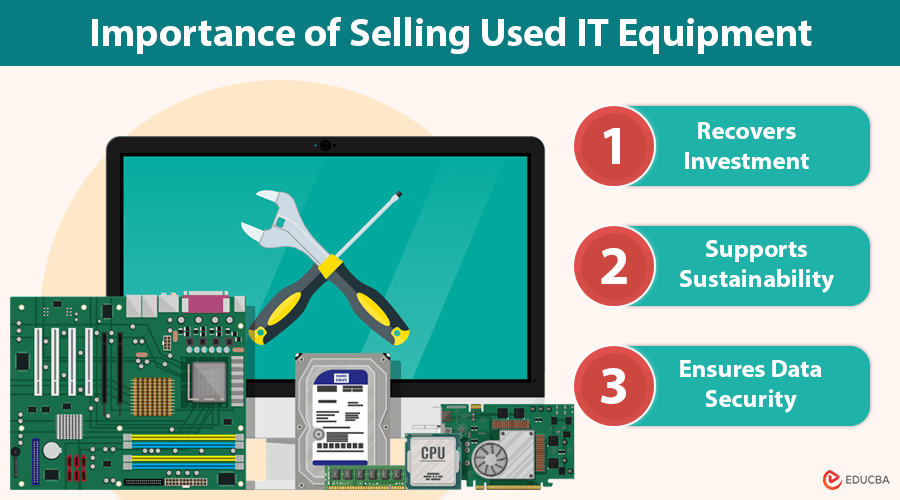
Introduction to Selling Used IT Equipment
In the fast-paced tech world, businesses frequently upgrade their IT infrastructure to stay ahead. This often leads to a surplus of used IT equipment. Instead of letting it go to waste, companies can sell used IT equipment to recover some of their investment, ensure data security, and contribute to sustainability. This guide will cover everything you need to know about selling used IT equipment, including its benefits, best practices, and step-by-step instructions to maximize returns.
Why Selling Used IT Equipment is Important?
Selling used IT equipment is essential because it:
1. Recovers Investment
IT hardware is a significant expense. By selling used IT equipment, businesses can recoup a portion of their costs, which can be reinvested into new technologies or other operational needs.
2. Supports Sustainability
Discarding IT assets improperly contributes to e-waste. Selling used IT equipment extends its lifespan, reduces landfill waste, and minimizes the demand for new device manufacturing, which helps the environment.
3. Ensures Data Security
Proper data wiping protocols are essential before selling IT equipment to prevent breaches. Secure disposal ensures that sensitive business information remains protected while reusing the equipment safely.
Benefits of Selling vs. Disposing
- Financial Gain: Selling provides a return on investment, while disposal is often a sunk cost.
- Supports the Circular Economy: Reusing devices reduces the need for new ones, conserving resources.
- Ensures Compliance: Proper resale through certified channels ensures adherence to data security regulations.
Steps to Selling Used IT Equipment Successfully
Here are the steps for selling used IT equipment:
Step 1: Assess Your IT Equipment
Before listing your used IT equipment for sale, evaluate its condition to determine its value and marketability.
- Evaluate Equipment Condition
-
- Inspect devices for physical damage.
- Test functionality to ensure they work properly.
- Identify any necessary repairs or upgrades.
- Determine Market Value
-
- Research similar listings online.
- Consider factors like brand, age, specifications, and demand.
- Reach out to IT resellers or refurbishers for price estimates.
- Securely Erase Data
-
- Use certified data-wiping software to remove all sensitive information.
- If necessary, opt for the physical destruction of storage media.
- Follow rules like GDPR and HIPAA.
Step 2: Find the Right Buyer or Reseller
- Research IT Resellers or IT Asset Disposition (ITAD) Companies
-
- Look for companies where you can buy or sell used desktops.
- Verify customer reviews and track records.
- Check certifications such as ISO 27001 (Information Security) and R2 (Responsible Recycling).
- Compare Selling Options
-
- Direct Sale: Sell directly to other businesses or individuals.
- ITAD Companies: Professional firms that handle the resale and secure disposal.
- Online Marketplaces: Platforms like eBay, Amazon, or specialized IT resale websites.
- Seek Recommendations & Reviews
-
- Ask industry peers for recommendations.
- Read customer testimonials before finalizing a buyer.
Step 3: Prepare Equipment for Sale
- Perform Necessary Repairs
-
- Fix minor issues like replacing batteries or cleaning dust buildup.
- If repairs are costly, weigh the cost against potential resale value.
- Clean & Organize Equipment
-
- Remove dust, stickers, or any identifying company marks.
- Include accessories like chargers or cables to enhance value.
- Document Specifications
List key details such as:
-
- Model and brand
- Storage and memory capacity
- Processor and operating system
- Special features
Step 4: Pricing & Negotiation
- Set a Competitive Price
-
- Research market rates for similar models.
- Consider age, condition, and functionality.
- If demand is low, adjust pricing or offer discounts.
- Be Open to Negotiation
-
- Have a target price but allow flexibility.
- Offer bulk discounts if selling multiple items.
- Be transparent about the condition to avoid disputes.
Step 5: Listing & Marketing Your Equipment
- Create an Attractive Listing
-
- Provide a clear, detailed description.
- Use high-quality images from different angles.
- Highlight key features and benefits.
- Choose the Right Sales Channel
-
- Online Marketplaces: eBay, Craigslist, Facebook Marketplace
- IT Resale Platforms: Gazelle, Decluttr, Back Market
- B2B Buyers: ITAD firms, corporate buyers, wholesalers
- Promote Effectively
-
- Use social media to reach potential buyers.
- Post on industry forums and LinkedIn groups.
- Consider paid advertising for bulk sales.
Step 6: Secure Payment & Logistics
- Communicate Clearly with Buyers
-
- Respond to inquiries promptly.
- Provide honest information about the device’s condition.
- Ensure Secure Payment Methods
-
- Use trusted platforms like PayPal, Escrow.com, or direct bank transfers.
- Avoid unsecured payment options like wire transfers.
- Secure Packaging & Shipping
-
- Use anti-static bags, bubble wrap, or foam padding.
- Choose reliable couriers with tracking options.
- Consider insurance for high-value items.
- Confirm Delivery
-
- Provide tracking details to buyers.
- Request confirmation upon receipt.
- Address any issues if they arise post-delivery.
Step 7: Handling Unsold Equipment
- Lower Prices or Offer Discounts
-
- Reduce prices if items remain unsold for an extended period.
- Offer bundle deals to attract buyers.
- Explore Trade-In or Buyback Programs
-
- Some manufacturers and resellers offer trade-in credits for old equipment.
- Check eligibility with brands like Dell, Apple, or HP.
- Donate or Recycle Responsibly
-
- Donate to non-profits, schools, or community centers.
- Use certified e-waste recycling programs if resale is not an option.
Final Thoughts
Selling used IT equipment is a smart way to recover investment, promote sustainability, and ensure data security. By following these tips, businesses can handle the resale process well and get the best returns.
Recommended Articles
We hope this guide on selling used IT equipment has been helpful. Check out these recommended articles for more insights on IT asset management, secure data disposal, and maximizing resale value.

